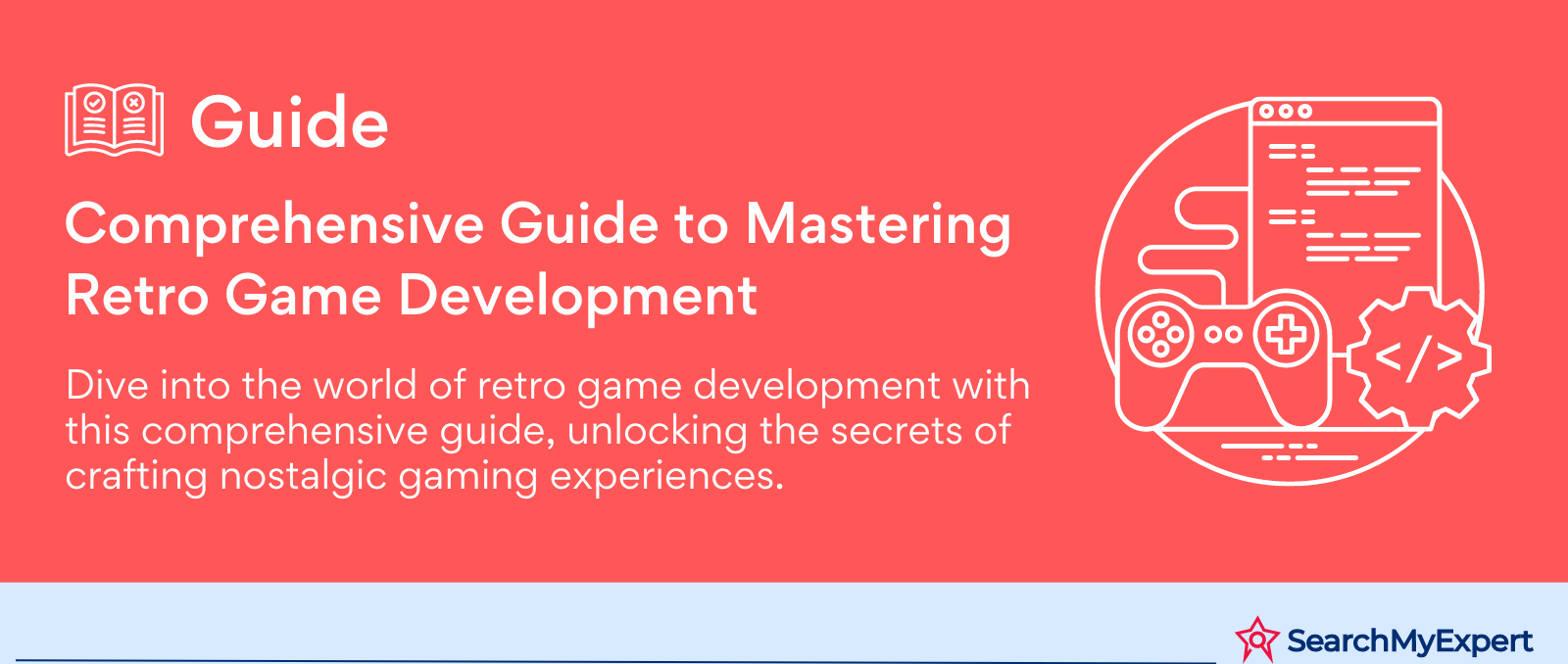Comprehensive Guide to Mastering Retro Game Development

The Allure of Retro Gaming: Capturing Nostalgia and Uniqueness
The Allure of Retro Gaming
Retro gaming conjures images of pixelated heroes and 8-bit soundtracks, inviting a journey down memory lane. Why do these games, with their seemingly primitive graphics and limited sound capabilities, continue to captivate us? The answer lies in their nostalgia, simplicity, and the unique charm that modern games often struggle to replicate.
Nostalgia: A Trip Down Memory Lane
Retro games are more than just software; they are time capsules. They evoke memories of simpler times, reminding players of their childhood or youth. This emotional connection is a powerful draw. The sights and sounds of games like 'Super Mario Bros.' or 'Pac-Man' trigger a sense of familiarity and comfort, transporting players back to moments spent huddled around television screens or arcade cabinets.
Unique Charm: Simplicity and Creativity
The charm of retro games also stems from their simplicity. In an era where modern games often overwhelm with their complexity and graphics, retro games stand out with straightforward gameplay and imaginative designs constrained by technical limitations. This simplicity encourages creativity, both in design and in play.
Learning from the Past
Additionally, retro games offer invaluable lessons for both players and developers. They demonstrate the importance of core gameplay mechanics and the power of storytelling without relying heavily on advanced graphics. For aspiring game developers, studying retro games is a masterclass in the fundamentals of game design.
Why Develop Retro Games?
The development of retro-style games has seen a resurgence, and for good reason. These games offer unique opportunities for developers, both professional and amateur.
Dedicated Audience
There's a dedicated audience for retro games, spanning multiple generations. This audience appreciates the art style, gameplay, and nostalgia. They're passionate, engaged, and often vocal in their communities, making them a valuable market.
Creative Freedom
Developing retro games often allows for more creative freedom. The focus shifts from competing in graphical fidelity to innovative gameplay and storytelling. Developers can experiment with genres, narratives, and mechanics without the pressure of meeting mainstream expectations.
Learning and Growth
Retro game development is also an excellent learning opportunity. It's a way to hone skills in design, programming, and art within manageable scopes. Developers can focus on the essentials of fun and engagement, laying a solid foundation for more complex projects.
Understanding Retro Genres and Platforms
Retro gaming spans various eras and platforms, each with its unique characteristics.
Arcade Cabinets
Arcade cabinets, often seen as the birthplace of video gaming, focused on immediate, intense gameplay. Games like 'Space Invaders' and 'Donkey Kong' were not just about passing levels; they were about high scores and public accolades in local arcades.
Early Consoles
The introduction of home consoles brought gaming into living rooms. The Atari 2600, NES, and Sega Genesis were pioneers, offering a range of games from platformers to RPGs. These consoles introduced iconic franchises that are still loved today.
Popular Genres
Retro games covered various genres, each with distinct gameplay mechanics. Platformers like 'Super Mario Bros.', RPGs like 'Final Fantasy', and puzzle games like 'Tetris' offered diverse experiences. Understanding these genres is crucial in appreciating retro gaming's impact.
Design Principles of Retro Games
Focus on Core Gameplay Mechanics
The Heart of Gameplay: Simplicity and Engagement
Retro games thrive on the elegance of simplicity. Unlike contemporary games with complex mechanics and sprawling narratives, retro games focus on straightforward, easily graspable gameplay loops. Consider the act of jumping in 'Super Mario Bros.' or the relentless ghost-dodging in 'Pac-Man'. These simple actions form the core of an engaging, addictive experience.
Perfecting the Loop
The key to a successful retro game is perfecting this core loop. It's about finding that balance where the mechanics are easy to understand but challenging to master. Each iteration of the loop offers a slightly different challenge, keeping the player engaged and pushing them to improve.
Rewarding Skill and Progress
A fundamental aspect of these loops is the sense of accomplishment and progression. Whether it's scoring points, collecting items, or unlocking new levels, retro games excel in rewarding players, often in real-time. This immediate feedback loop is crucial in maintaining player interest and satisfaction.
Mastering Pixel Art
Embracing Limitations as a Canvas
Pixel art is more than a style; it's a medium defined by its limitations. Early game artists worked with a limited palette and resolution, turning these constraints into a distinctive artistic style. From the chunky, abstract shapes of 8-bit graphics to the more detailed and expressive 16-bit era, pixel art has a charm and appeal that transcends its technical boundaries.
Styles Across Eras
The evolution from 8-bit to 16-bit brought about a significant change in visual style. Where 8-bit games were more abstract due to limitations, 16-bit games started to show more detail, closer to what the creators intended. This transition is crucial in understanding the scope and capability of pixel art in game design.
Crafting a Visual Identity
Pixel art in retro games isn't just about nostalgia; it's about crafting a visual identity that stands out. Effective pixel art conveys character and story with minimal detail, using colors and shapes strategically to create memorable characters and worlds.
Sound Design and Music
The Unmistakable Charm of Chiptunes
Chiptune music, made using the sound chips of old consoles and computers, is a hallmark of retro gaming. These melodies are not just background music; they are an integral part of the gaming experience. The catchy, looping chiptunes of games like 'Tetris' or 'The Legend of Zelda' are as iconic as the games themselves.
Nostalgic Sound Effects
Sound effects in retro games hold a special place in the hearts of gamers. The jump sound in 'Super Mario Bros.' or the 'Pew Pew' of 'Space Invaders' are instantly recognizable. These sounds were often simple due to technical constraints, but their creativity and impact were immense.
Enhancing Gameplay with Audio
Good sound design in retro games does more than entertain; it enhances gameplay. Audio cues can signal danger, success, or changes in the game environment, playing a crucial role in the gaming experience.
Choosing Your Tools and Technology for Retro Game Development
Retro-Specific Game Engines
Tailored Engines for Retro Aesthetics
When venturing into retro game development, selecting the right engine is crucial. While many modern engines are designed for 3D, high-fidelity games, several offer tools specifically tailored for retro-style 2D game development. For instance, Unity, renowned for its versatility, includes robust 2D tools ideal for creating pixel-perfect retro games. Similarly, Godot, an open-source engine, is acclaimed for its user-friendly interface and flexibility in 2D game development, making it a favorite among indie developers.
Engine Features for Retro Gaming
Key features to look for in these engines include sprite management, tileset support, and pixel-perfect rendering. These capabilities allow developers to authentically recreate the look and feel of classic games. Additionally, many engines provide tools for animation and physics that can be adapted to suit the simpler mechanics of retro games.
Accessibility and Community
The choice of engine often comes down to accessibility and community support. Engines like Unity and Godot boast large communities, offering extensive documentation, tutorials, and forums where developers can seek advice and share experiences.
Emulators and Development Kits
Role of Emulators in Development
Emulators are invaluable in retro game development, serving both as a source of inspiration and a practical tool for testing. They allow developers to run classic games, providing insight into the mechanics and design choices of the era. Additionally, emulators enable testing of new games on virtual versions of old hardware, ensuring compatibility and authenticity in gameplay experience.
Official Development Kits
For those seeking an even more authentic development experience, official development kits for classic consoles are an option. These kits enable developers to write and test games for specific hardware, ensuring that the games run seamlessly on the intended platforms. However, they often require more technical expertise and can be harder to obtain.
Open Source Resources and Frameworks
The Power of Open Source
The open-source community offers a wealth of resources for retro game developers. There are numerous libraries and frameworks specifically designed to simplify the creation of retro-style games. These resources often include pre-built game mechanics, graphic rendering capabilities, and sound processing tools that are optimized for retro game development.
Advantages of Open Source Tools
Using open source tools can significantly accelerate the development process, allowing developers to focus on the unique aspects of their games rather than reinventing the wheel. Moreover, these tools are often free and come with supportive communities that continuously improve and update them.
Programming and Mechanics Implementation in Retro Games
Retro Game Programming Languages
Choosing the Right Language
Programming languages are the backbone of game development, and choosing the right one is critical. For retro games, languages like C++, C#, and Lua are popular choices. C++ is known for its performance and control, making it ideal for games requiring intricate mechanics or optimizations. C#, often used with Unity, offers a balance of power and ease of use, suitable for a wide range of retro games. Lua, with its simplicity and flexibility, is commonly used for scripting in games, allowing for quick iterations and modifications.
Language and Engine Compatibility
The choice of programming language is often influenced by the chosen game engine. For example, Unity developers typically use C#, while Godot supports its own scripting language, GDScript, which is similar to Python. It’s important to consider the compatibility between the chosen language and the engine to ensure a smooth development process.
Collision Detection and Physics
Simplicity in Collision and Physics
In retro games, collision detection and physics don't need to be complex. Simple bounding box collisions are often sufficient for games like platformers or shooters. The key is to ensure that these systems are responsive and consistent, providing a fair and enjoyable experience for the player.
Fine-Tuning for Game Feel
The "feel" of a game is significantly influenced by its collision and physics. Fine-tuning these elements can make the difference between a game that's frustrating and one that's satisfying to play. It's about striking the right balance between realism and fun, keeping in line with the retro aesthetic.
Testing and Iteration in Retro Game Development
Targeted Playtesting
The Importance of Targeted Feedback
Playtesting is a critical phase in game development, especially for retro games. Targeting dedicated retro gamers for feedback ensures that the game appeals to its intended audience. These players can provide valuable insights into the game's mechanics, aesthetics, and overall feel, drawing from their experience with classic games.
Organizing Playtesting Sessions
Effective playtesting involves structured sessions where players engage with the game in controlled environments. Developers can observe gameplay, gather quantitative data (like completion times, success rates), and qualitative feedback (player thoughts and feelings). This data is crucial for identifying areas that need refinement.
Refine Mechanics and Balance
Perfecting Game Mechanics
The essence of a good retro game lies in its mechanics. Controls need to be tight and responsive, providing the player with a sense of mastery and control. Gameplay mechanics should be intuitive yet challenging, encouraging players to keep trying and improving.
Balancing the Difficulty Curve
A well-designed difficulty curve is key to retaining player interest. It should gradually increase, providing a sense of progression and achievement. Balancing this curve requires careful testing and adjustment to ensure it's neither too easy (becoming boring) nor too hard (leading to frustration).
Polish and Optimization
Importance of Performance and Polish
In the final stages of development, polishing the game and optimizing its performance is crucial. This includes ensuring that the game runs smoothly across different systems, fine-tuning visual effects, and possibly adding additional features that enhance the overall experience.
Adding the Final Touches
Polish can include minor adjustments to graphics, improving sound quality, or refining UI/UX elements. It's about creating a cohesive, seamless experience that transports players back in time while still providing the comforts of modern gameplay.
Distribution and Marketing of Retro Games
Choose Your Platform
Navigating Distribution Platforms
The choice of distribution platform is a significant decision in the journey of a retro game. Digital platforms like Steam or mobile app stores offer broad reach and accessibility. They are ideal for indie developers due to their low entry barriers. On the other hand, physical distribution, such as limited edition cartridges or CDs, can appeal to collectors and enthusiasts, adding a unique allure to the game.
Platform-Specific Considerations
Each platform comes with its considerations. Digital platforms require an understanding of their specific guidelines and algorithms, while physical distribution involves logistics and additional costs. The choice often depends on the game's target audience and the developer's resources.
Community Engagement
The Power of Community
Engaging with the community is essential in the marketing of retro games. Retro gaming forums, social media groups, and online communities are excellent places to build a presence. These platforms allow developers to connect with potential players, gather feedback, and build anticipation for the game.
Strategies for Community Engagement
Effective community engagement involves regular updates, participative discussions, and responding to feedback. Exclusive sneak peeks, developer diaries, or beta testing opportunities can significantly boost interest and loyalty among community members.
Embrace Retro Aesthetics and Marketing
Leverage Nostalgia in Marketing
The marketing of a retro game should embrace its nostalgic essence. This involves using pixel art, retro-themed graphics, and references to classic games in promotional materials. Nostalgic branding resonates with the target audience, invoking memories and emotions associated with the retro era.
Promotional Strategies
Creative promotional strategies like retro-themed trailers, merchandising (like pixel art posters or figurines), and collaborations with influencers in the retro gaming sphere can enhance visibility and appeal. The key is to capture the spirit of retro gaming in every aspect of marketing.
Beyond the Basics: Elevating Retro Game Development
Advanced Retro Techniques
Unleashing Creativity with Advanced Techniques
Retro games, while rooted in simplicity, can be enhanced significantly with advanced design techniques. Incorporating special effects like screen shakes, particle effects, or dynamic lighting can add depth and polish without losing the retro charm. These subtle enhancements can dramatically improve the visual and tactile feedback, making the gameplay more immersive and satisfying.
Dynamic Environments for Enhanced Engagement
Introducing dynamic environments can transform a static, predictable world into a lively and ever-changing landscape. Elements like changing weather, time of day, or interactive backgrounds add layers of complexity and interest, keeping players engaged and intrigued.
Unique Mechanics: The Spice of Retro Gaming
One area where developers can truly innovate is in game mechanics. Introducing unique gameplay elements or twists on classic mechanics can set a game apart. This could mean new types of puzzles, innovative enemy AI, or mechanics that play with player expectations, drawing them deeper into the game world.
Modernizing Retro Concepts
Bridging Eras with Design Philosophies
Modern game design offers a wealth of philosophies and techniques that can enhance retro games. This includes concepts like inclusive design, ensuring games are accessible to a wider audience, or employing sophisticated narrative techniques to tell more engaging and complex stories.
Contemporary Storytelling in Retro Games
Storytelling in games has evolved significantly. Retro games can benefit from these advancements by incorporating deeper narratives, character development, and branching storylines. This approach can breathe new life into the classic retro aesthetic, offering a fresh experience even to seasoned gamers.
Balancing Nostalgia with Innovation
The key challenge in modernizing retro concepts is balancing nostalgia with innovation. It's about respecting the roots and appeal of retro gaming while bringing something new and exciting to the table. This balancing act can make the difference between a game that feels like a mere imitation and one that stands as a testament to the evolution of the genre.
Building a Retro Game Portfolio
Crafting a Diverse Portfolio
For game developers, building a portfolio of retro games can be both a passion and a strategic move. Developing a series of games allows for the exploration of different genres, mechanics, and artistic styles within the retro domain. It also offers the opportunity to build a brand and a following.
Series Development: Expanding Universes
Developing a series of games can be a great way to deepen the game world and explore different facets of the universe you’ve created. Sequels or spin-offs can expand on the lore, introduce new characters, and explore different gameplay styles, all while maintaining a cohesive feel.
Growing as a Developer
Each game in a portfolio is a chance to grow and refine your skills. It’s an opportunity to experiment with new ideas, learn from feedback, and continually evolve as a developer. Embracing a range of projects can lead to a versatile and impressive body of work that showcases your depth and talent in the field of retro game development.
Conclusion
In the realm of retro game development, we journey through a world where nostalgia meets innovation, where the charm of pixel art intertwines with modern game design principles, and where the simplicity of yesteryear's gameplay merges with today's technological advancements. This guide has traversed the intricate paths of creating retro games, from understanding their unique allure and mastering their design principles, to selecting the right tools, perfecting gameplay through testing, and effectively distributing and marketing the final product. We've delved into the realms of advanced techniques and modernizing retro concepts, emphasizing the importance of keeping the essence of retro gaming alive while pushing the boundaries of creativity and technology.
Aspiring developers embarking on this journey of retro game creation are not just revisiting the past; they're contributing to a dynamic and ever-evolving genre that continues to captivate players across generations. The key takeaway is the balance between honoring the retro spirit and embracing modern possibilities. Whether you're crafting your first pixelated adventure or expanding your portfolio, remember that each game is a unique fusion of nostalgia and innovation, a testament to the timeless appeal of retro gaming and a tribute to its enduring legacy in the digital world.
Redefine gaming innovation with Game Development Firms.
share this page if you liked it 😊
Other Related Blogs

Mastering Docker for App Development: A Comprehensive Guide to Benefits, Use-Cases, and Alternatives
STAY UP TO DATE
GET PATH'S LATEST
Receive bi-weekly updates from the SME, and get a heads up on upcoming events.
Contact Us











